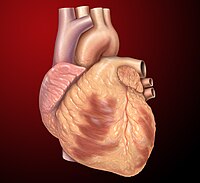
Photo from wikipedia
Abstract Left ventricle outflow tract obstruction can have catastrophic hemodynamical consequences. Patients with severe aortic stenosis undergoing transcatheter aortic valve replacement are at risk of developing this serious complication in… Click to show full abstract
Abstract Left ventricle outflow tract obstruction can have catastrophic hemodynamical consequences. Patients with severe aortic stenosis undergoing transcatheter aortic valve replacement are at risk of developing this serious complication in the postprocedural period. We present how a drug refractory left ventricle outflow tract obstruction, observed in a 76 year old female after transcatheter aortic valve replacement, was successfully treated with permanent atrioventricular pacing. After the procedure we observed an increase of gradients in left ventricle outflow tract to maximal gradient 96mmHg and mean gradient 46mmHg. The mechanism of left ventricle outflow tract obstruction was systolic anterior motion of the mitral valve. Despite fluids and increased dose of beta-blocker the was no improvement on control echocardiography. A decision to implant a dual chamber pacemaker was made in order to try do decrease the gradients. An immediate decrease in left ventricle outflow tract gradients after activation of sequential pacing with short atrioventricular delay was observed. Awareness of this method may prove helpful to cardiothoracic anesthesiologists treating patients after transcatheter aortic valve replacement
Journal Title: Journal of cardiothoracic and vascular anesthesia
Year Published: 2020
Link to full text (if available)
Share on Social Media: Sign Up to like & get
recommendations!